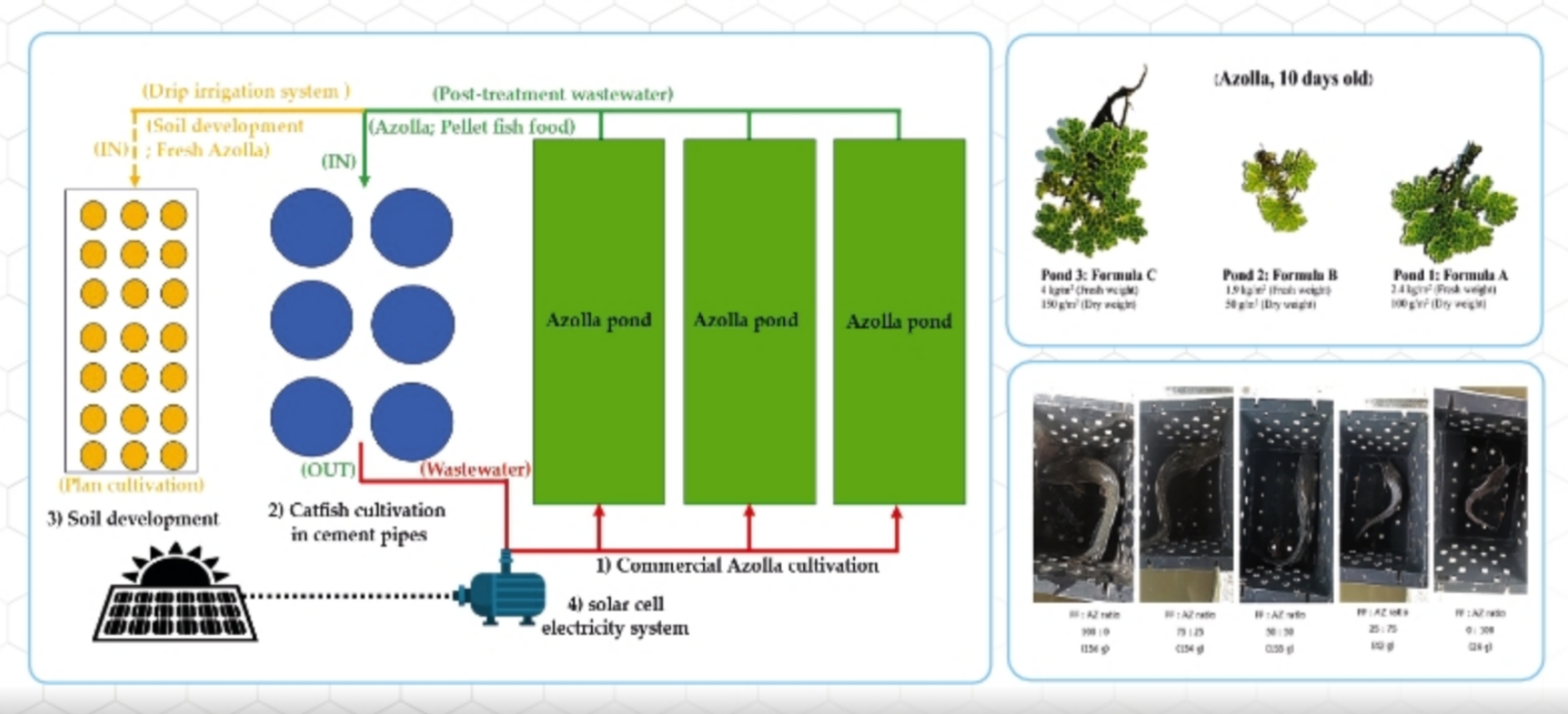Innovative Prototype of Zero-Waste Food Production System to Support Integrated Farming
Main Article Content
บทคัดย่อ
งานวิจัยมีวัตถุประสงค์เพื่อสร้างต้นแบบนวัตกรรมระบบการผลิตอาหารแบบของเสียเป็นศูนย์เพื่อสนับสนุนการทำเกษตรแบบผสมผสาน โดยนวัตกรรมดังกล่าวเป็นนวัตกรรมเชิงกระบวนการ (Process Innovation) ประกอบ 4 กระบวนการ สามารถสรุปผลได้ดังนี้ 1) การเพาะเลี้ยงแหนแดงเชิงพาณิชย์ สามารถเพาะเลี้ยงแหนแดงสดได้ 4 กิโลกรัมต่อ 1 ตารางเมตร ในเวลา 10 วัน โดยใช้สูตรเฉพาะจากงานวิจัยซึ่งอาหารสูตร C ประกอบด้วยมูลวัว 58 กิโลกรัมและร็อคฟอสเฟส 1.2 กิโลกรัม เป็นสูตรอาหารที่ดีที่สุดในการใช้เลี้ยงแหนแดงในบ่อขนาด 38.40 ตารางเมตรหรือ 11.52 ลูกบาศก์เมตร โดยใช้น้ำทิ้งจากบ่อเลี้ยงปลาดุกมาทำการเลี้ยงแหนแดง เมื่อครบเวลาเวลา 10 วัน น้ำที่ผ่านการบำบัดจากการเลี้ยงแหนแดงหมุนเวียนกลับไปเลี้ยงปลาดุกและใช้กับระบบน้ำหยดในการปลูกมะเขือยาว แหนแดงมีความสามารถในการบำบัดน้ำเสียได้ดีทำให้น้ำมีคุณภาพดีขึ้น 2) การเลี้ยงปลาดุกในท่อซีเมนต์ เป็นระบบการเลี้ยงปลาดุกแบบน้ำหมุนเวียน ประหยัดต้นทุนและเป็นมิตรกับสิ่งแวดล้อมไม่มีการปล่อยน้ำเสียออกนอกระบบ (Zero-waste) โดยใช้น้ำที่ผ่านการบัดจากการเลี้ยงแหนแดงในกระบวนการที่ 1 และใช้อาหารปลาอัดเม็ดจากแหนแดงที่อัตราส่วนอาหารสำเร็จรูปต่อแหนแดงสด 50:50 ซึ่งเป็นอัตราส่วนที่ดีที่สุด ในการเลี้ยงปลาดุก เพื่อลดต้นทุน ภายใน 12 สัปดาห์ (3 เดือน) ได้ปลาดุกน้ำหนักประมาณ 155 กรัมต่อตัว (6 ตัวต่อกิโลกรัม) แล้วแปรรูปเป็นปลาดุกร้า 3) การพัฒนาดินปลูก โดยอัตราส่วนมูลไส้เดือน 1 : แหนแดงสด 1 : แกลบดำ 1 : ดิน 1 เป็นสูตรที่ดีที่สุดจากงานวิจัย ใช้น้ำที่ผ่านการบำบัดจากการเลี้ยงแหนแดง (กระบวนการที่ 1) กับระบบน้ำหยดในการปลูกมะเขือยาว มะเขือยาวสามารถเจริญเติบโตได้ดี ทำให้ผลผลิตมะเขือยาวสูงสุดถึง 1,869 กิโลกรัม/ไร่ และกระบวนการที่ 4 ใช้ระบบไฟฟ้าจากโซล่าเซลล์ (ระบบพลังงานทดแทน) ใช้งานจริงในระบบเพื่อลดต้นทุนค่าไฟฟ้า ผลลัพธ์ทางเศรษฐกิจจากนวัตกรรมต้นแบบในพื้นที่ 1 ไร่ มีรายได้เฉลี่ยหมุนเวียนกลับมาจากการทำปลาดุกร้าและมะเขือยาว เป็นเงิน 108,536 บาท (หักต้นทุนแล้ว) รายได้เฉลี่ย 21,707 บาท/เดือน ซึ่งการแปรรูปทำให้มีรายได้เพิ่มขึ้น 43.38 เปอร์เซ็นต์ ดังนั้นต้นแบบนวัตกรรมดังกล่าวจากงานวิจัยมีความคุ้มค่าทางเศรษฐศาสตร์มากกว่าการทำเกษตรแบบเชิงเดี่ยว เป็นแนวทางให้เกษตรสามารถพึ่งพาตนเองได้สู่ความยั่งยืน
Article Details

This work is licensed under a Creative Commons Attribution-NonCommercial-NoDerivatives 4.0 International License.
References
Srichan.T; Kosolkittiamporn. S. 20 years of national strategy for the development of Thailand. Journal of Modern Learning Development. 2023, 8(1), 413-435.
Morales-Polo, C.; Cledera-Castro, M.D.M. An optimized water reuse and waste valorization method for a sustainable development of poultry slaughtering plants. Desalination Water Treat. 2016, 57, 2702-2711. https://doi.org/10.1080/19443994.2015.1033652
Cuevas, J.; Daliakopoulos, I.N.; del Moral, F.; Hueso, J.J.; Tsanis, I.K. A Review of Soil-Improving Cropping Systems for Soil Salinization, Agronomy, 2019, 9, 295. https://doi.org/10.3390/agronomy9060295
Lopez-Mosquera, M.E.; Fernández-Lemaa, E.; Villaresa, R.; Corralb, R.; Alonsob, B.; Blancob, C. Composting fish waste and seaweed to produce a fertilizer for use in organic agriculture. Procedia Environ. Sci. 2011, 9, 113-117. https://doi.org/10.1016/j.proenv.2011.11.018
Phdungpran, J.; Wangwiboonkit, S. The use of Azolla (Wolffia globosa), Azolla spp., and Lemna minor to reduce metabolism of Nile tilapia (Oreochromis niloticus) cultured in concrete tanks. Master of Science Thesis, King Mongkut's Institute of Technology Ladkrabang. Bangkok. 2020.
Nenciu, F.; Voicea, L.; Cocarta, D.M.; Vladut, V.N.; Gabriel M.; Arsenoai, V.-N. Zero-Waste" Food Production System Supporting the Synergic Interaction between Aquaculture and Horticulture. Sustainability. 2022, 14, 13396. https://doi.org/10.3390/su142013396
Dhaker, D.L.; Karthik, R.; Maurya, S. Cultivation of Azolla- A Proteinaceous Fodder for Livestock. Agricultural and Environment, 2021, 2(11), 50-52.
APHA. Standard methods for the examination of water and wastewater 22th edn, American Public Health Association. 2012, Washington DC, USA.
AOAC Official Methods of Analysis. 15th Edition, Association of Official Analytical Chemist. 1990, Washington DC. [10] Wongbung, W. Azolla and utilization in rice field. Natural Agriculture Journal. 1994, 11(3), 44-50.
Rattanakun, W. Red Azolla. Institute for the Promotion of Teaching Science and Technology. 2014, Available online: http://biology.ipst.ac.th/?p=880. (accessed on April 1, 2024).
Department of Fisheries. What is oxygen in water? Why do we need to measure oxygen in water?, 2024, Available online: https://www4.fisheries.go.th/local/index.php/main/view_activities/16/116613 (accessed on April 26, 2024).
Chartchumni, B.; Kumla, S.; Rayan, S.; Wongjunda, J. Climbing perch culture wastewater treatment with Azolla microphylla. Khon Khen Agriculture Journal, 2022, 50(6), 1567-1579.
Weirich, C.E.; Feiden, A.; Souza, C.S.; Marchetti, C.R.; Aleixo, V.; Klosowski, É.S. Temperature influences swine wastewater treatment by aquatic plants. Scientia Agricola. 2020, 78(4), e20190325. https://doi.org/10.1590/1678-992x-2019-0325
Napaldet, J.T.; BuotJr, I.E.;. Zafaralla, M.T.; LitJr, I.L.; Sotto, R.C. Effect of phytoremediation on the morphoanatomical characters of some aquatic macrophytes. Biodiversitas. 2019, 20(5), 1289-1302. https://doi.org/10.13057/biodiv/d200519
Basak, B.; Pramanik, A. H.; Rahman, M. S.; Tarafdar, S. U.; Roy, B. C. Azolla (Azolla pinnata) as a feed ingredient in broiler ration, Int. J. Poult. Sci. 2002, 1(1/3), 29-34. https://doi.org/10.3923/ijps.2002.29.34
Khatun, A.; Ali, M. A.; Dingle, J. G. Comparison of the nutritive value for laying hens of diets containing azolla (Azolla pinnata) based on formulation using digestible protein and digestible amino acid versus total protein and total amino acid, Anim. Feed Sci. Technol. 1999, 81(1/2), 43-46. https://doi.org/10.1016/S0377-8401(99)00071-1
Alalade, O.A.; Lyavi. E.A. Chemical Composition and the Feeding Value of Azolla (Azolla pinnata) Meal for Egg-Type Chicks. International Journal of Poultry Science. 2006, 5(2), 137-141. https://doi.org/10.3923/ijps.2006.137.141
Bocchi, S.; Malgioglio, A. Azolla- anabaena as a Biofertilizer for Rice Paddy Fields in the Po Valley, a Temperate Rice Area in Northern Italy. International Journal of Agronomy. 2010, 1, 1-5. https://doi.org/10.1155/2010/152158
Klinkong, T. Eggplant bush arrangement. Economic vegetables. 2013, 04/45, 70-71.
Thiranithiwat. K. Soil pH. Source: Available online. 2024, https://www.mfa.go.th/th/content/5d5bcd6215e39c3060010516?cate=5d5bcb4e15e39c306000684f. (accessed on April 26, 2024).
Horticultural Research Institute. Growing of eggplant and long eggplant, Department of Agriculture. 2024, Available online: https://www.rakbankerd.com/agriculture/print.php?id=5102&s=tblplant. (accessed on 18 May 2024).

